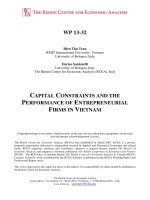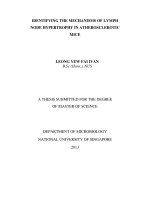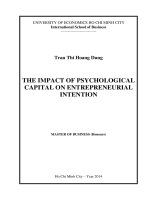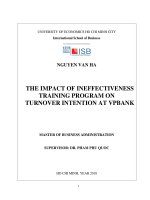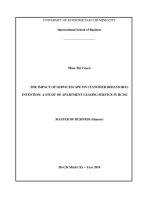Identifying the determinates of entrepreneurial intention
Bạn đang xem bản rút gọn của tài liệu. Xem và tải ngay bản đầy đủ của tài liệu tại đây (400.09 KB, 12 trang )
309
Chapter 14
Identifying the Determinates
of Entrepreneurial Intention
Muhammad Khalique
Mirpur University of Science and Technology (MUST), Pakistan
ABSTRACT
The prime aim of this study was to explore the determinants of entrepreneurial intention among undergraduate students at university level. This study employs attitude towards the behavior, subjective norm
and perceived behavioral control as predictors and entrepreneurial intention as a dependent variable.
The data were gathered through structured questionnaire. Respondents of this study were picked through
convenience sampling technique. A total of 400 sets of questionnaire were distributed to the targeted
respondents while 384 individuals were participated in the study. This study was a descriptive in nature.
Most of the respondents showed their intention to be entrepreneur. This study will be a milestone for
potential researchers. In future, researchers can conduct empirical studies on this topic.
INTRODUCTION
In a contemporary business environment organizations are facing very tough business competitions.
Technological advancement, globalization, high volatility of customers demand and political crises
has much influence on the business environment. To counter these challenges innovation, creativeness,
entrepreneurship and flexibility need to be encouraged. Subsequently, to get competitive advantages
businesses required entrepreneurial skills. These skills will be a survival tool for the enterprises to stay
alive in the market.
Davidsson, (1995) argued that the entrepreneurship among the young generation had leads to the
economic growth of government, innovation, employment and economic prosperity. Many studies such
as (Nafukho and Helen, 2010; Dickson, et al., 2008) illustrated that entrepreneurship is the vital economic
force to generate new jobs. Entrepreneur fully employs the chances that exist in their environment, and
he has the skills to form the new business. Entrepreneurs represent as self-employed individuals. Entrepreneur is a person in which combine the various sources and lead them precious and worth whereas in
the psychology field, they defined the entrepreneur as an individual that motivated by the needs to gain
or achieve certain things, to test and to achieve objectives (Lee et. al. 2012).
DOI: 10.4018/978-1-4666-9455-2.ch014
Copyright © 2016, IGI Global. Copying or distributing in print or electronic forms without written permission of IGI Global is prohibited.
Identifying the Determinates of Entrepreneurial Intention
Entrepreneurship plays active role in the development and growth of economy. Harper (1991) argued
that in order to encourage the development of economic in less developed nations; the way is actively
support and engaged in entrepreneurial activities. This is because the growth of entrepreneurship is
critical and essential for economic progress in both developed nation and evolving country. Moreover,
entrepreneurship has main function to accomplish the financial growth. Furthermore, the study of Kuratko
(2005) had recognized the central role and tasks of an entrepreneur. He affirmed that the new chances
for an individual to take part in the progress of socio-economic are the contribution of an entrepreneur
that will lead to recover the economics.
Malaysia is a developing country and her economy is mainly based on small and medium enterprises.
Therefore, entrepreneurship is essential for the development of national economy. In addition, Malaysia
is an emerging nation. According to Malaysian Plan (2010-2015) government has aim to achieve the
high income country in 2020. It encourage adolescence to engaged themselves in economics activities
either public or private sector. However, according to the study of Badaruddin et al. (2012), the factors
that influence the development of entrepreneurship included inadequate of the finances, talents or expertise, and technology as well. These factors had cause the poor growth in term of business and then
lead to the economics issues in Malaysia (Badaruddin et. al., 2012).
Many studies had carried out to increase the understanding on factors that effect on entrepreneurial
intentions such as (Choo and Wong, 2006; Bird, 1988; and Lee et al., 2012). However, during literature
review it was found that there is lack of studies on the determinants of entrepreneurial intentions among
the undergraduate students in Malaysia. This is supported by Kobia and Sikalieh (2010) affirmed that
research regarding entrepreneurship is still at initial stage and should be carried out. Therefore, this
study is essential and vital.
LITERATURE REVIEW
The term of entrepreneurship was initially created by Cantillon in which it refers to self-employment.
An entrepreneur represents as a director of the business in his standpoint (Dariani, 2004). Entrepreneurship is a process of guiding, organizing, supervising and undertaking the risks. In addition, the growth
of economics is a function that consists of improvement and generation of new supplies and resources.
Entrepreneurship is defined as the process in which an individual has the ability to change the idea
into a kind of business. Davidsson (1995) stated that the entrepreneurship has been focused over the last
20 years in-respect of job creation, innovation of product and process. Invention is an important example
of contributions made by entrepreneurs. Baron and Shane (2008) claimed that entrepreneur represents the
“engines of economic growth”. They then observed that there is different means to describe the meaning of entrepreneurship. On the basis of literature review we conclude that attitude, subjective norms
and perceived behavioral control could be used as independent variables for this study to examine the
entrepreneurial intention of undergraduate students.
ENTREPRENEURIAL INTENTION
In order to establish and develop a new business, the first step that required is consideration of entrepreneurial intention (Lee and Wong, 2004). Bagozzi, and Yi (1989) in their Psychological research suggest
310
Identifying the Determinates of Entrepreneurial Intention
that intention is the key forecaster of consequent planned behaviour. This idea is supported by the fresh
research study of Astuti and Martdianty (2012) in Indonesia determined that when the deed is hard to
examine or foresee, intention is the most excellent predictors of planned behavior.
As a result, entrepreneur intention is essential trend in which engaged the extensive cognitive studies. Assumption that did by Krueger, et al., (2000) stated that the choice to build the business activity is
undergone a series of planned rather than through trained response. Therefore, they applied the theory
of planned behavior (Azjen, 1991) in their research study.
In the theory of planned behavior, intention to undertake a certain behavior is the central building blocks that used by many researchers in their study (Ajzen, 1991). According to Ajzen, there is a
positive relationship between the intention and work performance. When the intention to carry out the
specified behavior is strong, then the probability of work performance is high. In addition, Ajzen (1991)
determined the intention as effort that an individual plan to employ and how hard and willingness they
try to perform the behaviour.
Eagly & Chaiken (1993) defined intention as motivation of an individual to perform a behavior in
his or her aware plan and it is different with attitude while attitude means summary evaluation (Eagly &
Chaiken 1993). Bird (1998) established that the intention is a kind of mind that motivating the awareness and action of an individual against a particular objective or target in order to accomplish somewhat
they desire. Intention stands for the driving force for a person to make a decision. Many prior researches
also used the theory of planned behavior to indicate the entrepreneur intention for example (Autio et
al., 2001) and (Linan & Chen, 2009) had utilized each component in the theory of planned behavior to
build up the entrepreneur career.
A study that carried out by Olufunso (2010) on the entrepreneurial intention among graduate students
and found that there is a weak intention and most of the respondents desire to work in private corporation
or public organization. As explained by (Davidsson, 1995), the folks prefer to self-employed since they
see the entrepreneurship is an appropriate career course and a manner to achieve their aim instead to
pursue their individual idea and obtain the benefit reward from it (Barringer & Ireland, 2010). Gilaninia
(2013) argued that the results indicated that there has positive liaison between entrepreneurial intention
of students and the criterions that include family support, self-efficacy beliefs and the subjective norms.
However, the result found that there is no significant association between entrepreneurial intention and
attitude.
Attitude
The first element in the Theory of planned behaviour is attitude towards the behaviour. Attitude refers to
favourable or unfavourable long term appraisal for an individual, emotional sentiment, and action leaning
toward several objects or ideas. (Kotler and Keller, 2006). They recognized that the mind of a person
is shaped by attitudes, affect their preferable towards the object and afterwards force them towards or
away from that object. Hence, attitudes will shape the behaviour of an individual to behave in certain
way (Kotler and Keller, 2006).
According to Ajzen (1991), attitudes refer desirable and undesirable assessments that form people
behaviour. Attitudes reveal the individual’s favourable or unfavourable sentiment to carry out behaviour.
According to Xavier et al. (2009), attitude towards behavior defined as the degree to which an individual
start up the business based on their perception towards opportunities to establish the business.
311
Identifying the Determinates of Entrepreneurial Intention
Tsen, et al., (2006) studies give an idea about component of attitude. There are three extremely interdependent building blocks of attitude that consists of beliefs, feelings, and behavioral intention. This
attitude then affects the consumers’ decision to buy online or e-shopping. Therefore, when refer back the
research studies conducted by Schwarz et al. (2009), aspiration of an individual to be an entrepreneur
refers as attitude towards entrepreneurship in which it is the most critical determinants of entrepreneurial
intention in TPB.
Meanwhile, Douglas and Fitzsimmons (2008) completed a research to investigate the general attitudes towards the intention to establish the business of an individual. The results from their investigation
showed that people with higher enthusiasm towards the entrepreneurship has positive attitude to the
threat and independence.
Followed by the past research study of Franke and Luthje (2004), the result showed that there is
positive and strong relationship between attitude and intention to develop into an entrepreneur among
business undergraduates in Germany and United States. But, the study of Douglas and Fitzsimmons
(2008) found that there is negative relationship between the entrepreneurial intention and attitude against
the effort of work.
Conversely, as indicated in the prior research of Krueger et al. (2000), the most prominent aspects of
entrepreneurial intention of individuals is attitude towards behaviour in which consists of self-efficacy
and self-governing. Nevertheless, they found no significant relationship among the social norm and
entrepreneurial intention in this study.
In the previous research of Schwarz et al. (2009), the studies examine the relationship between the
intention to become an entrepreneur and attitudes towards the alteration, independence, accomplishment,
money and competitiveness among undergraduate students. The studies proved that the most important
determinant of entrepreneurial intention is attitude. Moreover, the studies found that the person who
looked for more money shows the high intention to launch the new business than to works as employee.
Besides, Autio et. al. (2001) determines that undergraduate who intends to attain their goals and ready
to success will involve their intention to be self in employment. This finding is consistent with the study
that carried out by (Lüthje and Franke, 2003) among business students.
The high need for the new enterprise will lead to high intention to build the business. Additional data
provided by Ariff et al. (2010) among the Malay undergraduate in accounting field in Malaysia proved
that the correlation between attitude and intention to be an entrepreneur is significantly correlated.
Subjective Norm
Subjective norm or in other term is social factor and it defined as “perceived social pressure to do or not
to perform the behaviour” (Ajzen, 1991). According to Fishbein and Ajzen (1975), subjective norms
defined as a kind of pressure resulted from the public environment that will change the intention of a
person to carry out certain performance and do something. According to Ajzen, when the attitude, subjective norms and perceived behavioural control towards the behaviour of person is more favourable,
then intention to do and act the behaviour of that person will strong.
Subjective norms not only applied to test the purchase intention, but it also used broadly by the researchers to determine the entrepreneurial intention. For example, Cheah and Phau (2005) had used the
subjective norm in their study to determine the purchase intention of an individual. The result report
312
Identifying the Determinates of Entrepreneurial Intention
that social influences are strongly influence an individual purchase choice. Follow by the prior study
of Francis, Lee et al., (2012) showing that social networking likes Google, Facebook, twitter, Flickr,
YouTube, and etc. has an impact on purchase intention towards green products.
Perceived Behavioral Control
Perceived behavioral control is a new determinant of intention and behavior that extended by Ajzen
and Madden in 1986 from TRA into Theory of Planned Behaviour (TPB). According to Ajzen (1991),
perceived behavioural control defined as the perception of consumers towards their ability in order to
present a specified behaviour. It determines extent an individual to direct the behaviour and the confidence of an individual to perform the task. Ajzen then explain that perceived behavioral control related
to the belief regarding the opportunities that hold by an individual and resources that required in the
behavior (Ajzen, 1991).
Besides, Ajzen also make contrast between perceived behavioral control and perceived self- efficacy.
To further explain the perceived behavioral control, Ajzen investigated two individuals to perform a
behavior in same level of intention. The result affirmed that individual with the high confidence in his
or her abilities are more likely to attain the high achievement compare to the one who has doubt. Khalifa
and Limayem (2003) has examined the online purchase intention, perceived behavioral control has a
strong association with actual internet purchases. Other than that, George (2004) found that Planned
Behavioural Control (PBC) has influence consumers online shopping behaviour.
On the other hand, Franke and Lutjhe (2004) used the perceived behaviour control to predict the
entrepreneurial intention among students. The result shows that entrepreneurial intention is affected by
awareness towards barriers and difficulty. When the awareness of the support is high, then the entrepreneurial intention will also be high.
RESEARCH METHODOLOGY
Primary data were gathered through structured questionnaire forms. The targeted respondents were undergraduate students of Universiti Malaysia Sarawak, Malaysia. The respondents were selected through
convenience sampling technique. The employed constructs were measured through five point Likert
Scale. The questionnaire form was based 3 sections. Section A deals with the respondents demographic
and section B indicates three dimensions of variables, attitude, subjective norm and perceived behavioral
control. Section C deals dependent variable which is entrepreneurial intention. In this study a total of 400
sets of questionnaire were distributed to the targeted respondents while 384 individuals were participated.
Descriptive Analysis
The prior study of Zikmund et al. (2010) defined the descriptive analysis as the process in which the
raw data will be transforming into a form that comprehend and understand more easily. The collected
data were analyzed by using the software Statistical Package for Social Sciences (SPSS) version 21.0.
After using SPSS, frequency had been used to generate the frequency count to know the demographics
information of the respondents. Moreover, through Section A, the mean, standard deviation, frequency
distribution and percentage distribution of the demographic information were analyzed.
313
Identifying the Determinates of Entrepreneurial Intention
Table 1. Detail of gender
Valid
Frequency
Percent
Valid %
Cumulative %
Male
153
39.8
39.8
39.8
Female
231
60.2
60.2
100.0
Total
384
100.0
100.0
Table 2. Detail of age group
Frequency
Percent
Valid %
Cumulative %
Below 20
18
4.7
4.7
4.7
21-23
294
76.6
76.6
81.3
24-26
65
16.9
16.9
98.2
27-29
5
1.3
1.3
99.5
30 and Above
2
0.5
0.5
100.0
384
100.0
100.0
Frequency
Percent
Valid %
Cumulative %
Malay
133
34.6
34.6
34.6
Chinese
187
48.7
48.7
83.3
Indian
20
5.2
5.2
88.5
100.0
Total
Table 3. Races of respondents
Others
44
11.5
11.5
Total
384
100.0
100.0
Demographics Information of the Respondents
Table 1 shows that a total of 153 respondents with (39.8%) of male and 231 with (60.2%) female were
participated in this study. Data showed that in this study the female gender has more proportion as
compared to the male gender.
Table 2 shows that from total respondents, 18 participants (4.7%) were below than 20 years; while
294 respondents (76.6%) were 21-23 years old and 65 respondents (16.9%) were between 24-26 years
old. Moreover, the Table 2 shows that 5 respondents (1.3%) were of 27-29 years old and 2 respondents
(0.5%) were 30 and above years old.
Table 3 shows the ethnicity of respondents. From the total respondents in which n=384, the number
of Malay respondents is 133 (34.6%), Chinese respondents is 187 (48.7%), Indian respondents is 20
(5.2%) and Others race respondents is 44 (11.5%).
Table 4 shows the percentages of the religion among the respondents in Universiti Malaysia Sarawak that were participated in this study. Out of 384 respondents, 142 respondents (37%) were Muslim
while 90 respondents (23.4%) were Christian. However, 136 respondents (35.4%) were Buddha and 16
respondents (4.2%) were from others religion.
314
Identifying the Determinates of Entrepreneurial Intention
Table 4. Religion information
Frequency
Percent
Valid %
Cumulative %
Islam
142
37.0
37.0
37.0
Christian
90
23.4
23.4
60.4
Buddha
136
35.4
35.4
95.8
Others
16
4.2
4.2
100.0
Total
384
100.0
100.0
Table 5. Families own business information
Frequency
Percent
Valid %
Cumulative %
Yes
125
32.6
32.6
32.6
No
259
67.4
67.4
100.0
Total
384
100.0
100.0
Table 5 shows that a total of 125 (32.6%) respondent’s families have their own business while 259
(67.4%) respondents’ families do not have their own business.
Measurement of the Constructs
Table 6 represents that the item 3 has the highest mean which is 3.84. 23.4% of respondents strongly
agree with this item meanwhile 1.6% of respondents strongly disagree. However, item 5 have the lowest mean which is 3.4635. There are 38.5% of respondents remaining neutral to the item and 37.2% of
respondents agree with that statement.
Table 7 illustrated that the item 4 has the highest mean which is 3.8255. In this item, 51.0% of the
respondents agree with it while 20.6% of respondents are strongly agreed with that statement. However,
the statement 2 has the lowest mean which is 3.1641. 28.4% of the respondents were agreed to the statement and 6.8% of the respondents were strongly agreed to that statement.
Table 6. Summary central tendency of attitude towards the behavior
No.
Statement
SD
D
N
A
SA
Mean
1
I rather be my own boss than have a
secure job.
2.3%
9.4%
33.6%
36.7%
18.0%
3.5859
2
A career as entrepreneur is attractive
for me.
1.3%
8.1%
29.2%
43.0%
18.5%
3.6927
3
If I had the opportunity and resources,
I’d like to start a firm.
1.6%
6.8%
21.1%
47.1%
23.4%
3.8411
4
Being an entrepreneur would entail
great satisfactions for me.
1.3%
5.2%
27.9%
47.1%
18.5%
3.7630
5
I believe that if I were to start my
business, I will certainly be successful.
1.0%
11.7%
38.5%
37.2%
11.5%
3.4635
315
Identifying the Determinates of Entrepreneurial Intention
Table 7. Summary central tendency of subjective norms
No.
Statement
SD
D
N
A
SA
Mean
1
My parents are positively oriented
towards my future career as an
entrepreneur
2.3%
17.2%
34.4%
33.3%
12.8%
3.3698
2
My friends see entrepreneurship as a
logical choice for me.
2.9%
19.8%
42.2%
28.4%
6.8%
3.1641
3
I believe that people, who are
important to me, think that I should
pursue a career as an entrepreneur.
4.4%
17.2%
40.6%
28.6%
9.1%
3.2083
4
In my University, students are actively
encouraged to pursue their own ideas
1.6%
6.5%
20.3%
51.0%
20.6%
3.8255
5
There is a well-functioning support
infrastructure in my University to
support the start-up of new firms.
2.3%
14.1%
43.5%
33.1%
7.0%
3.2839
Table 8 represents item 6 has the highest mean which is 3.4766. 43.8% of the total respondents were
agreed while 9.9% of respondents are strongly agreed with it. Statement 1 has the lowest mean 2.6432.
There are only 17.2% of the respondents were agreed with the statement while 32.6% of the respondents
were disagreed with it.
Table 9 showed that the item 4 has the highest mean which is 3.675. 45.1% of the respondents were
agreed with it while 8.1% of the respondents were disagreed. Followed by the statement 1 in which the
mean is 3.5495. However, the item 2 has the lowest mean 3.2708. 12.5% of the respondents were strongly
agreed while 6.0% of the respondents were disagreed with it.
Table 8. Summary central tendency of perceived behavioral control
No.
316
SD
D
N
A
SA
Mean
1
To start a firm would be easy
for me.
Statement
12.5%
32.6%
35.4%
17.2%
2.3%
2.6432
2
To keep a firm working well is
easy for me.
7.0%
33.6%
35.9%
20.1%
3.4%
2.7917
3
I know how to develop an
entrepreneurial project.
5.7%
24.2%
40.9%
25.0%
4.2%
2.9766
4
If I tried to start a firm, I would
have a high probability of
succeeding.
1.3%
15.1%
47.9%
29.7%
6.0%
3.2396
5
If I want, I could become selfemployed after my studies
2.3%
12.2%
36.2%
38.0%
11.2%
3.4349
6
To start my own firm would
probably be the best way for
me to take advantage of my
education.
2.3%
11.2%
32.8%
43.8%
9.9%
3.4766
Identifying the Determinates of Entrepreneurial Intention
Table 9. Summary central tendency of entrepreneurial intention
No.
Statement
SD
D
N
A
SA
Mean
1
I prefer to be an entrepreneur
rather than to be an employee in a
company.
2.6%
10.7%
33.3%
35.9%
17.4%
3.5495
2
My professional goal is to become
an entrepreneur.
6.0%
15.6%
36.2%
29.7%
12.5%
3.2708
3
I’m determined to create a firm in
the future.
2.6%
13.8%
31.3%
39.3%
13.0%
3.4635
4
I will make every effort to manage
my own firm.
1.8%
8.1%
27.3%
45.1%
17.7%
3.6875
5
I have a very serious thought in
starting my own firm.
2.9%
11.7%
32.3%
36.7%
16.4%
3.5208
CONCLUSION AND DISCUSSION
Entrepreneurial intention plays a vital role to create and grow every business. The aim of this study was
to identify factors that effect on the intention of undergraduate students to become an entrepreneur. The
findings of this study showed that most of the respondents have intention to become an entrepreneur.
Moreover, this study reported that attitudes, subjective norms and perceived behavioral control have role to
build an entrepreneurial intention among the undergraduate students. Subsequently, this research revealed
that we can enhance the intention to become an entrepreneur among undergraduate students. Like other
studies this study also has some limitations for example this research was focused only undergraduate
students from one university, cross sectional nature, and limited sample size. This study is at preliminary
stage, therefore further studies could be conducted empirically to examine the role of each factors on
the entrepreneurial intention of undergraduate and postgraduate students among different universities.
Moreover, this study encouraged future studies to explore entrepreneurial intention in others field.
ACKNOWLEDGMENT
Authors gratefully acknowledged the contribution of Lah Fung Lim student of the Faculty of Economics
and Business, Universiti Malaysia Sarawak, for assisting in this paper.
REFERENCES
Ajzen, I. (1991). The theory of planned behavior. Organizational Behavior and Human Decision Processes, 50(2), 179–211. doi:10.1016/0749-5978(91)90020-T
Ariff, M., & Abubakar, S. Y. (2005). Strengthening Entrepreneurship in Malaysia. Retrieved from www.
mansfieldfdn.org/programs/program_pdfs/ent_malaysia.pdf
Astuti & Martdianty. (2012). Students’ Entrepreneurial Intentions by Using Theory of Planned Behavior:
The Case in Indonesia, The South East Asian. Journal of Management, 6(2).
317
Identifying the Determinates of Entrepreneurial Intention
Autio, E., Keeley, R. H., Klofsten, M., Parker, G. G. C., & Hay, M. (2001). Entrepreneurial intent among
students in Scandinavia and in the USA. Enterprise and Innovation Management Studies, 2(2), 145–160.
doi:10.1080/14632440110094632
Badaruddin, M. N. B. A., Arokiasamy, L., Nordin, N. M., Yusof, H., & Zakaria, T. (2012). Cyber-Entrepreneurial Intention Among Business Undergraduates In Institutions Of Higher Learning In Malaysia.
2nd International Conference on Management.
Bagozzi, R., Baumgartner, H., & Yi, Y. (1989). An investigation into the role of intentions as mediators
of the attitude-behaviour relationship. Journal of Economic Psychology, 10(1), 35–62. doi:10.1016/01674870(89)90056-1
Baron, R. A., & Shane, S. A. (2008). Entrepreneurship: A Process Perspective (2nd ed.). Mason, OH:
Thomson South-Western.
Barringer, B. R., & Ireland, R. D. (2010). Entrepreneurship: successfully launching new ventures (3rd
ed.). New Jersey: Pearson.
Bird, B. J. (1988). Implementing entrepreneurial ideas: The case for intention. Academy of Management
Review, 13, 442–453.
Cheah, I., & Phau, I. (2005). Toward a Framework of Consumers’ Willingness To Purchase Environmentally Friendly Products: A Study of Antecedents And Moderator. Proceedings of ANZMAC 2005
Conference (pp. 39-46).
Choo, S., & Wong, M. (2006). Entrepreneurial intention: Triggers and barriers to new venture creations
in Singapore. Singapore Management Review, 28, 47–64.
Dariani, A. M. (2004). Entrepreneurship: definitions, theories, models (5th ed.). Tehran: Pardis Publishing Company.
Davidsson, P. (1995). Determinants of entrepreneurial intentions. Paper prepared for the RENT IX
Workshop, Piacenza, Italy.
Dickson, P. H., Solomon, G. T., & Mark Weaver, K. (2008). Entrepreneurial selection and success:
Does education matter? Journal of Small Business and Enterprise Development, 15(2), 239–258.
doi:10.1108/14626000810871655
Douglas, E., & Fitzsimmons, J. (2008). Individual intentions towards entrepreneurship vs. intrapreneurship. ASGE.
Engle, R. L., Dimitriadi, N., Gavidia, J.V., Schlaegel, C., Delanoe, S., Alvarado, I., He, X. Buame,
S. and Wolff, B. (2010). Entrepreneurial intent: A twelve-country evaluation of Ajzen’s model of
planned behavior. International Journal of Entrepreneurial Behavior & Research, 16(1), 35–57 (doi:
11020063)10.1108/135525510
Fishbein, M., & Ajzen, I. (1975). Belief Attitude, Intention and Behavior. An Introduction to Theory and
Research. Reading, MA: Addison-Wesley Publishing Company.
318
Identifying the Determinates of Entrepreneurial Intention
Franke, N., & Luthje, C. (2004). Entrepreneurial Intentions of Business Students: A Benchmarking
Study. International Journal of Innovation and Technology Management, 1(3), 269–288. doi:10.1142/
S0219877004000209
George, J. F. (2004). The theory of planned behavior and Internet purchasing. Journal of Internet Research, 14(3), 198–212. doi:10.1108/10662240410542634
Gilaninia, S. Alipur, H.R & Tondar, Y. (2013). Effective Factors on Students’ Entrepreneurial Intent
of Islamic Azad University of Rasht Branch (Case Study Students Master of Business Management).
Interdisciplinary Journal of Contemporary Research in Business, 5(5).
Harper, M. (1991). The role of enterprise in poor countries. Entrepreneurship Theory and Practice,
15(4), 7–11.
Khalifa, M., & Limayem, M. (2003). Drivers of internet shopping. Communications of the ACM, 46(12),
233–239. doi:10.1145/953460.953505
Khalifa, M., & Limayem, M. (2003). Drivers of internet shopping. Communications of the ACM, 46(12),
233–239. doi:10.1145/953460.953505
Kobia, M., & Sikalieh, D. (2010). Towards a search for the meaning of entrepreneurship. Journal of
European Industrial Training, 34(2), 110–127. doi:10.1108/03090591011023970
Kotler, P., & Keller, K. L. (2006). Marketing management (12th ed.). Upper Saddle River, NJ: Pearson
Prentice Hall.
Krueger, N. F. Jr, Reilly, M. D., & Carsrud, A. L. (2000). Competing Models of Entrepreneurial Intentions. Journal of Business Venturing, 15(5-6), 411–432. doi:10.1016/S0883-9026(98)00033-0
Krueger, N. F. Jr, Reilly, M. D., & Carsrud, A. L. (2000). Competing Models of Entrepreneurial Intentions. Journal of Business Venturing, 15(5-6), 411–432. doi:10.1016/S0883-9026(98)00033-0
Kuratko, D. F. (2007). Entrepreneurial Leadership in the 21st Century. Journal of Leadership & Organizational Studies, 13(4), 1–11. doi:10.1177/10717919070130040201
Lee. W. N., Lim. B. P., Lim. L.Y., Ng. H. S & Wong. J. L. (2012). Entrepreneurial Intention: A Study
Among Students of Higher Learning Institution.
Linan, F., & Chen, Y.-W. (2009). Development and cross-cultural application of a specific instrument to measure entrepreneurial intentions. Entrepreneurship Theory and Practice, 33(3), 593–617.
doi:10.1111/j.1540-6520.2009.00318.x
Luthje, C., & Franke, N. (2003). The making of an entrepreneur: Testing a model of entrepreneurial
intention among engineering students at MIT. R & D Management, 33(2), 135–147. doi:10.1111/14679310.00288
Nafukho, F. M., & Helen Muyia, M. A. (2010). Entrepreneurship and socioeconomic development in Africa: A reality or myth? Journal of European Industrial Training, 34(2), 96–109.
doi:10.1108/03090591011023961
319
Identifying the Determinates of Entrepreneurial Intention
Olufunso, F. O. (2010). Graduate Entrepreneurial Intentions in South Africa: Motivations and Obstacles.
International Journal of Business and Management, 5(9), 87–98.
Schwarz, E. J., Wdowiak, M. A., Almer-Jarz, D. A., & Breitenecker. (2009). The effect of attitudes and
perceived environment conditions on student’s entrepreneurial intent: An Austrian perspective. Education + Training, 51(4), 272-291
Tsen, C. H., Phang, G., Hasan, H., & Buncha, M. R. (2006). Going green a study of consumers‟ willingness to pay for green products in Kota KinaBalu. International Journal of Business and Society, 7, 40–54.
Xavier, R., Ayob, N., Mohd Nor, L., & Yusof, M. (2010). The Global Entrepreneurship Monitor (GEM)
Malaysian Report 2010. Retrieved from />Zikmund, W. G., Babin, B. J., Carr, J. C., & Griffin, M. (2010). Business research methods (8th ed.).
New York: South-Western Cengage Learning.
320

